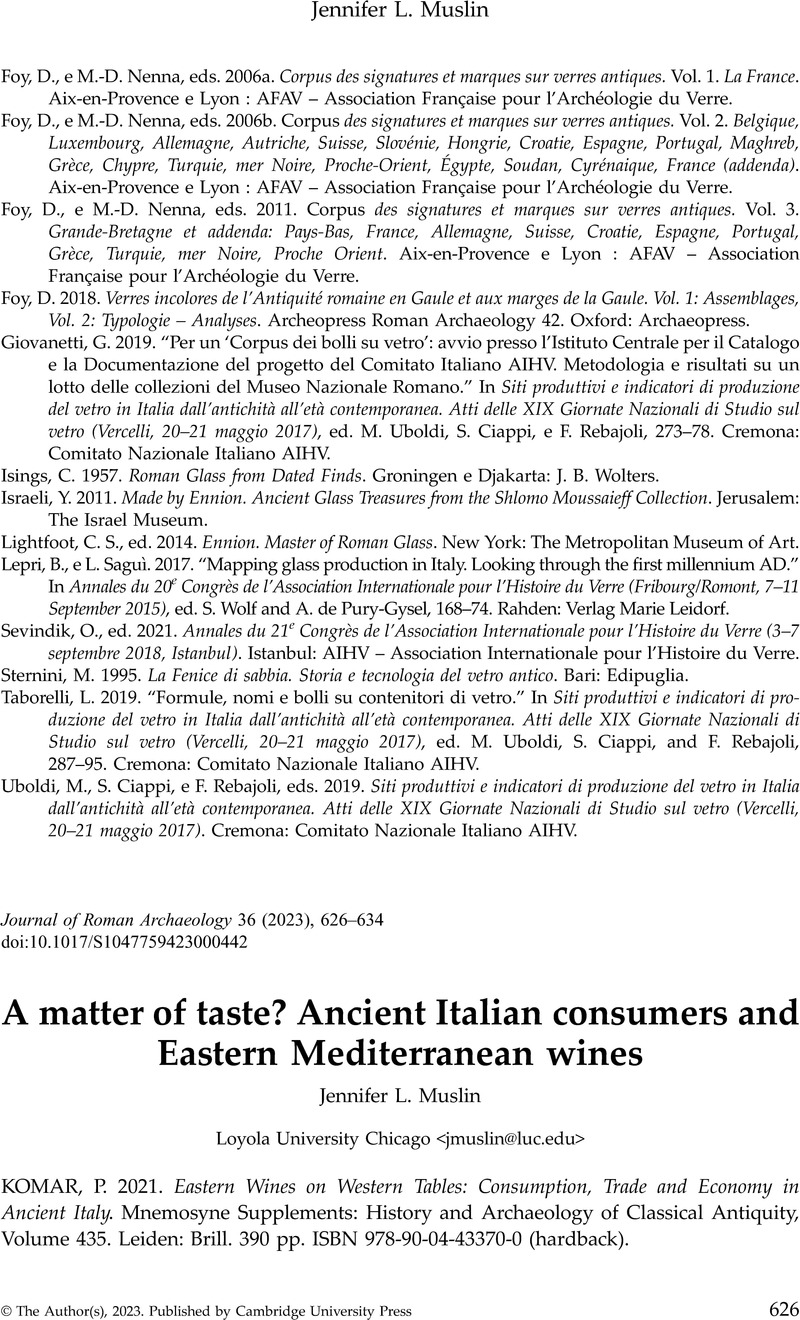No CrossRef data available.
Article contents
A matter of taste? Ancient Italian consumers and Eastern Mediterranean wines - P. KOMAR 2021. Eastern Wines on Western Tables: Consumption, Trade and Economy in Ancient Italy. Mnemosyne Supplements: History and Archaeology of Classical Antiquity, Volume 435. Leiden: Brill. 390 pp. ISBN 978-90-04-43370-0 (hardback).
Review products
P. KOMAR 2021. Eastern Wines on Western Tables: Consumption, Trade and Economy in Ancient Italy. Mnemosyne Supplements: History and Archaeology of Classical Antiquity, Volume 435. Leiden: Brill. 390 pp. ISBN 978-90-04-43370-0 (hardback).
Published online by Cambridge University Press: 23 November 2023
Abstract
An abstract is not available for this content so a preview has been provided. Please use the Get access link above for information on how to access this content.

- Type
- Book Review
- Information
- Copyright
- Copyright © The Author(s), 2023. Published by Cambridge University Press
References
Abdelhamid, S. 2013. “Against the throw-away-mentality: The reuse of amphoras in ancient Mediterranean maritime transport.” In Mobility, Meaning, and the Transformation of Things, ed. Hahn, H. P. and Weiss, H., 91–106. Oxford: Oxbow.CrossRefGoogle Scholar
De Sena, E. C. 2005. “An assessment of wine and oil production in Rome's hinterland: Ceramic, literary, art historical and modern evidence.” In Roman Villas around the Urbs. Interaction with Landscape and Environment. Proceedings of the Conference at the Swedish Institute in Rome, September 17–18, 2004, ed. Santillo Frizell, B. and Klynne, A., 135–49. Rome: Swedish Institute in Rome.Google Scholar
Finley, M. I. 1999. The Ancient Economy (updated with a new forward by I. Morris). Berkeley: University of California Press.10.1525/9780520353305CrossRefGoogle Scholar
Foley, B. P., Hansson, M. C., Kourkoumelis, D. P., and Theodoulou, T. A.. 2012. “Aspects of ancient Greek trade re-evaluated with amphora DNA evidence.” JAS 39: 389–98.Google Scholar
Gallimore, S. 2016. “Creticum vinum excellens? Reassessing the role of wine in Crete's identity.” In Food, Identity, and Cross-Cultural Exchange in the Ancient World, ed. Broekaert, W., Nadeau, R., and Wilkins, J., 36–50. Collection Latomus 354. Brussels: Éditions Latomus.Google Scholar
Di Giovanni, V. 2003. “Le anfore da trasporto. L'impianto fognario sottoposto al settore ovest del decumano di via Duomo.” In Da Puteoli a Pozzuoli. Scavi e ricerche sulla rocca del Rione Terra, ed. Crimaco, L., Gialanella, C., and Zevi, F., 79–93. Naples: Electa.Google Scholar
Di Giovanni, V. 2013. “Le dinamiche degli scambi economici nella Campania in età imperiale. Circolazione delle produzioni africane: ceramiche fini, anfore da trasporto e ceramiche da cucina.” In L'Africa Romana XIX. Trasformazione dei paesaggi del potere nell'Africa settentrionale fino alla fine del mondo antico, ed. Bastiana Cocco, M., Gavini, A., and Ibba, A., 1511–38. Collana del Dip. Storia Univ. Sassari 43. Rome: Carocci.Google Scholar
Hansson, M. C., and Foley, B. P.. 2008. “Ancient DNA fragments inside Classical Greek amphoras reveal cargo of 2400-year-old shipwreck.” JAS 35: 1169–76.Google Scholar
Komar, P. 2014a. “Greek wines for the Roman elite: In search of Eastern luxuries on Western tables.” Eos 101, no. 2: 227–44.Google Scholar
Komar, P. 2014b. “Consumption of Greek wines in Roman Italy – between literary and archaeological evidence.” Food & History Journal 12, no. 3: 99–131.CrossRefGoogle Scholar
Komar, P. 2016. “Wines from Cyprus and Cilicia in antiquity: Taste and trade.” Electrum 23: 155–85.Google Scholar
Komar, P. 2020. “In vino sanitas: Medical qualities of Greek wines.” MÉFRA 132, no. 2: 429–47.Google Scholar
Kourakou-Dragona, S. 2013. La vigne et le vin dans le monde grec ancien. Athens: Foinikas.Google Scholar
Lawall, M. 2011. “Socio-economic conditions and the contents of amphorae.” In PATABS II. Production and Trade of Amphorae in the Black Sea, ed. Tzochev, C., Stoyanov, T., and Bozkova, A., 23–33. Sofia: St. Kliment Ohridski Sofia University.Google Scholar
Molina Vidal, J., and Mateo Corredor, D.. 2018. “The Roman amphorae Average Capacity (AC).” OJA 37: 299–311.Google Scholar
Muslin, J. L. 2019. “Between Farm and Table: Oplontis B and the Dynamics of Amphora Packaging, Design, and Reuse on the Bay of Naples.” Unpublished doctoral diss., University of Texas at Austin.Google Scholar
Peña, J. T. 2007. Roman Pottery in the Archaeological Record. Cambridge: Cambridge University Press.10.1017/CBO9780511499685CrossRefGoogle Scholar




